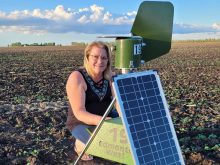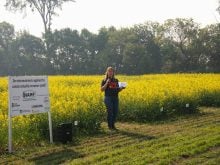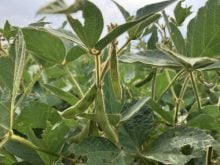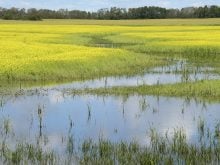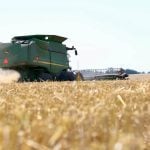The traditional adage of 1.4 million viable wheat plants per acre (32 viable plants per sq. foot) has just failed a crucial test under the scrutiny of cereal specialists at North Dakota State University.
In field trials that wrapped up the fourth week of August, NDSU research agronomist Joel Ransom found that in fields with high yield potential, the seed rate can be cut back to one million viable wheat plants per acre (23 viable plants per sq. foot). Although it will be months before he officially releases the data, Ransom reluctantly agreed to discuss his preliminary observations in a cellphone interview from the field.
Read Also

GSI’s GrainVue allows for remote grain bin monitoring
GSI’s GrainVue bin monitoring system allows producers to monitor grain conditions inside the bin and automate any drying, cooling or aerating that is needed to keep grain in peak condition.
“You’re catching me at a kind of controversial time in my life here,” he began hesitantly, pointing out that his findings run contrary to conventional wisdom on the need for seed.
“We’re just finishing up this seeding rate study this week. The results are suggesting that in the very high yielding environments, we actually reduce seeding rates. That goes against traditional thinking, which has always said you put down more seed in those high productivity areas.”
Ransom says the only area where it pays to increase your seeding rate is the middle-yielding zones, where he puts down slightly more seed than in the high yield zones. The fields he was harvesting last week in North Dakota gave the same conclusion as the trials he ran in Minnesota in 2017.
“In Minnesota last year, one million plants per acre (23 plants per sq. foot) gave the same yield or a higher yield than 1.4 million plants per acre (32 plants per acre).
“I think I could be quoted as saying that in an environment where you grow 70 bushels and greater wheat, the data supports reducing the seed rate by probably 200,000 plants per acre. We haven’t released this information yet, but I think this is where we’re going with the results.”
Ransom said many cereal agronomists recommend a higher seeding rate to reduce the number of tillers, which should result in more uniformity of heading. However, he said there is no data to support that assumption. There will still be tillers and there will still be some plants that are stragglers, he added.
The guideline for picking a spring wheat seeding rate should account for all the data we can factor in today, and consideration should also be given to future factors about which we may have no clue. There’s no way to intelligently work those numbers until you have a good grip on what you have for seed, according to wheat agronomist Phil Needham of Needham Ag Technologies in Kentucky.
Although Needham is based in the south, he has already made eight prairie province field trips this summer working with his clients in Manitoba, Saskatchewan and Alberta. He said any discussion of seeding rates must begin with the basics.
“We need to know the germination and the vigour, both with and without a fungicide seed treatment,” he said.
“Even in an area with no fusarium pressure, we need the tests to be conducted with and without treatment.”
He said the results typically show about 70 percent germination without the treatment and 95 percent with treatment. Although the spread can be greater, a 25 percent gap proves that a seed treatment is vital. His growers treat every seed, every acre, every year whether it’s wet or dry. Research shows that crops benefit from a fungicide seed treatment regardless of weather. Fusarium can rise up, even if the year starts out dry.
“Before the tests, we need a seed count for that seed lot,” he said.
“Guys who don’t clean their wheat very heavily often have 15,000 to 17,000 seeds per pound. Guys who do a better job cleaning their seed often have 12,000 to 14,000 seeds per lb., so obviously they have heavier, plumper seeds.
“Some of this discrepancy is the variety. Some of it has to do with how well the field was managed and the growing conditions that year. Some of it has to do with the soil in which your seed stock was grown. If it was planted in deeper soil with moisture, you’ll have a bigger seed that’s well filled out.
“I always encourage my clients to buy new seed, but if you’re planning on saving seed, make sure you plant future seed stock on your best ground. Always raise your seed wheat on your best soils with your best fertility and management. If the weather turns against you, those plants have a better chance. It’s common sense.”
Needham is adamant that farmers should throw out all pre-existing notions about pounds per acre of seed or bushels per acre of seed. He said the only concern should be the number of viable plants. Thinking in terms of pounds or bushels prevents producers from thinking in terms of viable plants.
“Some guys are on board with that, and they’ve been seeding according to plant population for 20 years,” he said.
“These guys have the best crops year after year. In a field with high moisture probability and high yield potential, I think 32 live wheat plants per sq. foot is still a good target. If you’re between 30 and 35 live plants per sq. foot, that should be ideal, but if you’re seeding in mid-May and the profile is dry, you might want to cut back a bit.”
Fields with deep, moist soil and high yield potential are the same fields with the highest fusarium risk. In the past, some growers have toyed with the idea of lower seeding rates so there is more space for air movement within the canopy.
“I would not take that position,” he said.
“To get a higher yield, you need a higher head count. If it’s a fusarium area, you start with varieties that have the best tolerance. Then you work on getting the timing of the fusarium fungicide just right. If you back off the seed rate in a high-risk year to bring the head count down, it’s my guess that yield will be lost regardless of conditions.”
Variable rate seeding is becoming a reality. Needham Ag Technologies has conducted numerous variable rate wheat seed trials, but the results are inconclusive. Needham said they’ve had as many yield increases as yield decreases.
There are proven benefits to variable rate fertility, especially with nitrogen and phosphate, because those yield bumps can be quantified, he added, but there is no such data for variable rate seeding.
Farmers rely on the information they receive from seed analyst labs when determining which seed lots go into their soil and which lots get shipped. Most farmers send samples to more than one lab and then blend the results when making their seed choice.
While the different labs generally agree on germination, disease, kernel weight and other factors, growers are sometimes perplexed by the varying cold vigour results they receive from competing seed labs. How do you know which lab has the most accurate cold vigour test?
The problem is not that any of the labs are wrong — it’s that there are a number of different methods that can be used to establish seed vigour. There has never been a standardized test for cold vigour like there is for seed germination.
To rectify the situation, prairie seed labs are working together to standardize a protocol for rating seed vigour. They hope to establish a common system so a farmer can make more accurate comparisons of seed lots, in the same way soil test labs over the years have worked to harmonize their protocols, said Jason Danielson, president of Discovery Seed Labs.
“We’re working with a group of seed analyst labs in Western Canada to create better consistency between labs,” he said.
“The system will be based on criteria set out by the International Seed Treatment Association protocol, but the challenge is that here in Canada we have that dormancy issue many other cereal-growing countries don’t have, so it’s not simply a matter of copying the ISTA protocols.
“It was supposed to have been finalized this summer, but there were too many details to look after. We have to correlate the vigour results from different labs with the results we see in the field, and that’s been a daunting task.
“It should be in place very soon. This will definitely be good news for farmers.”
How high can you push winter wheat yields by manipulating seeding rates? That’s a question Ducks Unlimited agronomist Ken Gross began delving into a couple years ago. Gross points out that pushing seeding rates higher in cereals is not the high-cost high-risk experiment it is with canola. Wheat seed is cheap.
“We’ve been researching this question of winter wheat seeding rates for the past couple years at the diversification centres,” he said.
“I got curious reading about how they push winter wheat yields in Europe and the mid-western states. They really go high on the seeding rate. I decided that’s something we can try here in Manitoba. One of the main benefits we see is a greater number of main plants per sq. foot. The main plants crowd out the tillers.”
Gross pauses to emphasize that for years, cereal agronomists have been encouraging growers to think in terms of viable plants per sq. foot rather than pounds or bushels per acre. Yield only comes from viable plants, not from stragglers or no-goes.
“With a weak stand of winter wheat, you get a lot of tillers and that results in a lot of different growth stages in the field,” he said.
“We generally spray twice in Manitoba with the second spray operation aimed at fusarium. But with different growth stages in the field, how do you get the timing right? Which growth stage is your target? If you have most of your crop all at the same stage, with mostly the main stems to deal with, you’ll get your timing right and the fungicide is more effective.”
Gross said farmers shouldn’t always let the crop planting guide be the final word on seeding rates. Most guides says winter wheat should be seeded to produce in the neighborhood of 23 viable plants per sq. foot.
“So this is interesting,” he said.
“I was out checking a field last week with a producer. He was running a comparison with seeding rates: two bu. per acre and three bu. per acre. In the three bu. per acre rows there were hardly any tillers and we counted 66 seeds on the main stems. That was about 30 to 33 plants per sq. foot. We estimated that yield would run in the mid-90s.
“In the two-bu. row, we counted only 22 seeds on the primary stem and fewer seeds on the secondary tiller. That was about 23 plants per sq. foot. We figured that crop would yield about 70 bu. It was a very visual lesson. Seed a high rate if you want a high yield.”





